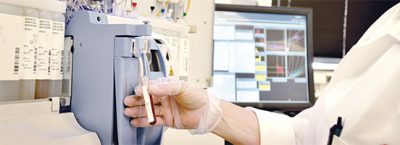The clinical pathology team is close at hand to face diagnostic challenges

When an animal at the Veterinary Medical Center needs to be diagnosed quickly, chances are that one or more tests will be run at the clinical pathology laboratory.
The “clin path” lab, one of the eleven service sections at the Diagnostic Center for Population and Animal Health (DCPAH), is housed on the second floor of the Veterinary Medical Center, just steps away from the VMC. While the rest of DCPAH is housed in its facility on Beaumont Road south of the VMC, the close proximity of clinical pathology is intentional. Of course, DCPAH’s other laboratory sections also perform critical testing needed in the diagnosis of VMC patients, but there is a special connection to the clinical pathology lab. There, four board-certified clinical pathologists and professors of clinical pathology in the Department of Pathobiology and Diagnostic Investigation—Drs. Mike Scott, Julia Stickle, Cheryl Swenson, and Jennifer Thomas—work to ensure accurate, on-the-spot diagnoses and to prepare the next generation of practitioners for the challenges they’ll encounter.
One of the aspects they find most appealing about their work is problem solving. Stickle says that during a rotating internship, “I discovered very quickly that solving the puzzle, getting to the answer of what’s going wrong, is the part that I like. Once I figure it out, I’m onto something else. Give me another case.”
Section Chief Thomas agrees that after being in practice for a couple of years, “I had the same experience as Julia. I was most intrigued by making the diagnosis.”
Scott adds, “I think we’re all on the same page that solving the riddle is fun. Not only that, I like to have the evidence in hand to support the conclusion and what we do is all about getting the information to help reach that conclusion.”
Swenson says she always liked reading mysteries and, unlike the others who found clinical pathology a bit later, she knew when she applied to vet school that she wanted to be a clinical pathologist. But for the same reasons—putting all the pieces of the puzzle together.
While shows like “CSI: Crime Scene Investigation” might be problem-solving for the masses, there are some similarities to the work that takes place in clinical pathology. Both circle in on the evidence. Both rely on current, real-life cases to stay fresh and relevant. There is a good, strong, and diverse caseload that comes to the clinical pathology lab from DCPAH clients as well as those cases that are thoroughly documented through the VMC. Because the VMC is a tertiary-care facility, these cases often are the interesting ones. Data from both sources can be extracted for use in the classroom.
“We certainly gather a lot of our teaching material from our diagnostic service. We try to delve into current cases and use those as the model,” says Thomas. In many ways, these clinical pathologists see themselves as following the same master apprentice system that goes back to the Middle Ages. In addition to the knowledge of the field, training in the use of tools and technology is essential. All four doctors agree that the use of microscopes must be maintained. Clinicians will be using microscopes— a basic tool—for the foreseeable future. The human eye is one of the most powerful tools we have and when combined with a microscope, that power is magnified. But using a microscope isn’t as natural as opening your eyes or blinking— like riding a bike, time and practice are essential.
“One of the biggest challenges of being capable of doing in-house diagnostic work is actually figuring out how to use the microscope correctly. You can’t figure that out from only being presented with digital images, you have to work through it and suffer a little bit,” says Scott.
But as tools and technology have advanced, more and more practices are doing testing in-house. While there are positive aspects to this, there are challenges as well. Quality assurance of the laboratory data is essential. At DCPAH, that is something that is provided for all of the laboratories, including clinical pathology. In the classroom, Scott and Stickle both cover in-house technology, including how to use it appropriately, when to use it, and when to step away from it.
Scott points out that, based on studies by some diagnostic labs, the norm is for practitioners to send out samples on healthy animals at the time of an annual checkup because they don’t feel they need the results as quickly. They do testing in-house for a sick animal, because they feel they do need the results right away. But that approach is backwards from a diagnostic perspective.
“It’s more important with a sick animal for someone more trained to look at it because they may pick up things that are there and unlikely to be there in the healthy animal,” Scott says.
Swenson adds, “Don’t just rely on the analyzer. The scope work is so critical.” In continuing education lectures, Scott says he uses cases to illustrate these points— where a result from an analyzer was incorrect because certain steps weren’t taken, or where an artifact was missed.
But the issue is complicated. Yes, there are cases where if someone had looked into a microscope they would have gotten the answer. But that isn’t true for every veterinarian or technician. It’s not true for every type of lesion. It’s important for practitioners to find their comfort zone and send out cases as needed.
When samples come to DCPAH’s clinical pathology lab, Swenson says, “If certain criteria are met, and it’s a fairly low threshold, what comes out of the analyzer—the data—and the blood smear are reviewed by a board-certified clinical pathologist.” And with these four clinical pathologists on the job, no case is too big or too small. They’re up for the challenge. In fact, they’re looking forward to it.
Posted: June 2013
Contact: Courtney Chapin
